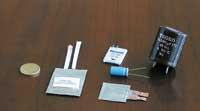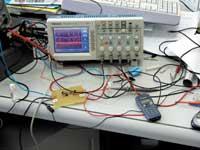"Supercapacitors have a special place in applications"
What is a capacitor?

Cendón Ione: The capacitor is, in short, an energy storage system consisting of two metal plates (electrodes) and a dielectric material between them. Therefore, the characteristics of the capacitor are given by two main factors: the amount of energy it stores and its power, that is, the time it can release the accumulated energy. Conventional capacitors cannot store much energy, but their release is very fast, that is, they are of great power.
Ritxar Aizpurua: Many electrical applications, even having a basic consumption, require at a given time a great power. So, to respond to this sudden demand, there are two options: install a powerful primary power supply, which for most of the time is wasted in a useless way or use a capacitor. The capacitor responds to the instant pulse and is loaded between the pulses. It is, therefore, a deposit of energy.
And what is the supercapacitor? What needs do you respond to?
I. S: As we have said, in some applications you need a great instantaneous power, such as in an electric car, when climbing slopes or advancing another car. In this case, both the storage capacity and the availability of large powers would be of great utility. These are the characteristics of the supercapacitor: it is able to store much more energy than conventional capacitors and also has a much higher power than the battery. Therefore, the supercapacitor adds the advantages of conventional batteries and capacitors.
What is the difference between the two?

I. S: A battery has a specific power of 1000 W/kg, approximately the conventional capacitor of 100,000 W/kg and the supercapacitor of 10.000 W/kg. Keep in mind that these numbers are standard and, of course, of higher power, but serve to have a reference. Energetically, the battery can store between 10-100 Wh/kg, the supercapacitor between 5-10 Wh/kg and the conventional capacitor 0.01-0.1 Wh/kg.
How does the supercapacitor store so much energy?
I. S: The load accumulated by a conventional capacitor can be increased by increasing the surface of the two electrodes and reducing the distance between them. But it is not a very practical method, since for some applications a giant capacitor would be necessary.
For the manufacture of the supercapacitor porous materials are used, usually carbon, instead of metallic electrodes, obtaining large surface electrodes. By putting these electrodes in contact with an electrolyte, a double layer of electrical load is formed, that is, the carbon acquires a positive charge and the electrolyte a negative charge. Due to the large surface of the double layer, much energy is accumulated in this system, increasing the capacity of the supercapacitor with the surface of the electrode.
Therefore, does the function of metal plates in conventional capacitors meet the carbon in the supercapacitor?

I. S: Yes, and the function of the interlaminar material meets the double layer that is formed when adding the electrolyte. And with such a large surface of the electrode, the capacity increases enormously; in conventional capacitors the capacity is measured in picofaradas and in the supercapacitors in faradas, hundreds of faradas or, at most, in thousands of faradas.
As for the power, how long can supercapacitors release energy?
R. R. A. A. Conventional capacitors can feed the system in a few milliseconds, and supercapacitors in a few tenths of a second or a few seconds and in a few minutes maximum, while batteries can last for hours, days or weeks.
Are all supercapacitors equal?
I. S: No, depending on the nature of the electrode, they can be of three types: carbon, metal oxide and polymers. However, carbon electrodes are the most used, since all those sold on the market use carbon electrodes because they are much more stable than others.
Aqueous or organic electrolytes can also be used. Among the aqueous, potash and sulfuric acid are generally used. However, they cannot be used with a potential greater than 1,2 volts, since from there the water breaks down. This is important because the energy that accumulates is proportional to tension. Therefore, aqueous electrolytes cannot store as much energy as organic ones.
With organic electrolytes the voltage can be raised up to 2.3 volts. In this case, we use tetraethylonium-tetrafluoroborate in acetonitrile. The resistance generated by these molecules is greater than that generated by aqueous electrolytes, so the organics have less power (they require more time to release energy).

In theory, we should choose depending on the application if it requires electrolyte, power or high energy, but in practice all the supercapacitors on the market have organic electrolytes, since the voltage difference is very high compared to aqueous ones.
Is this carbon in the form of graphite?
I. S: No, because graphite has a very low specific surface, less than 20 m 2 /g. The electrodes make active carbon, with an approximate surface of 2.000 m 2 /g. Without this minimum surface they do not work properly. In addition, it is important that the size of the pores is adequate, since the ions of the electrolyte must be able to penetrate the pores.
Finally, the quality is given by the large surface and by the adaptation of the pore diameter to the size of the ion. For this reason, different carbon materials (nanotubes, nanofibers, aerogels, etc.) are being investigated from CI?. and its activation treatments.
What is the most suitable primary energy source for supercapacitors?
R. R. A. A. There are currently numerous technologies that can be used as primary energy sources: air generators, photovoltaic panels, fuel cells, etc., but perhaps the most used for the moment are batteries. Every day there are better batteries in the market, capable of storing a lot of energy and offering great powers. For example, ion/polymer lithium batteries have already improved Ni/Cd or NiMH batteries that have so far been a benchmark. However, they are becoming more expensive.
Therefore, the supercapacitors can be used with cheaper batteries, which accumulate a lot of energy, and although they can not respond to the energy pulses, for this purpose can be used systems of supercapacitor of batteries.
In which systems can this type of solutions be applied?

R. R. A. A. In mobile phones, for example, Ni/Cd batteries are very used, as they are suitable for giving pulses. Mobile phones require two very short but very frequent pulse amps. However, low-power batteries could also be used if they are able to charge the supercapacitor between pulses. The capacitor would release pulses of energy, especially when connecting or calling the repeater.
I. S: In this way, in addition, the work of the batteries is facilitated and its useful life can be extended between 10 and 20%.
Are you testing this type of systems in CI??
R. R. A. A. Yes, that is one of our goals. We have already managed to power a mobile phone with a fuel cell, but with the help of the supercapacitor, since the power density of the fuel cells is quite reduced. On the other hand, we are working on a system that connects supercapacitors and batteries to feed high power pulse systems away from the electric grid. However, we are constantly looking for new applications for the use of supercapacitors.
Would you highlight other eye-catching applications?
R. R. A. A. The example of electric cars is very illustrative to understand the use of supercapacitors: to advance another car, climb a slope or accelerate sharply, you can use the energy accumulated by the supercapacitor. Thus, the primary source of energy should not be very large, so the system is cheap and light. In addition, this system can help reduce consumption if you use the braking energy to load the capacitor.
What problems do these systems have?

R. R. A. A. For example, spontaneous discharge is a big problem. Capacitors are valid when used but are not suitable for storing energy, if they do not release energy they lose over time. Therefore, you have to look for the right applications, otherwise, they only give problems. If they are on the circuit they must be used.
On the other hand, the voltage level of the supercapacitors is low (1V-2,5 V) and must be connected in series to obtain higher and useful stresses.
Applications will be invented; in many articles it has been written that supercapacitors are a new solution and now you have to look for problems with those solutions. They are useful in mobile phones, cars, photo cameras and many other devices. They can also be used to cope with power outages on computers, as they can provide time to store the information contained in memory.
Buletina
Bidali zure helbide elektronikoa eta jaso asteroko buletina zure sarrera-ontzian











